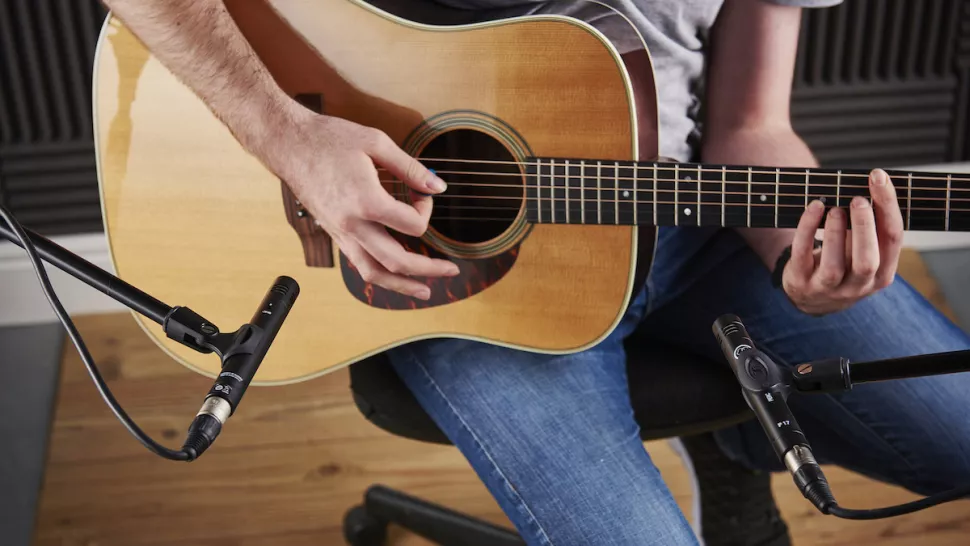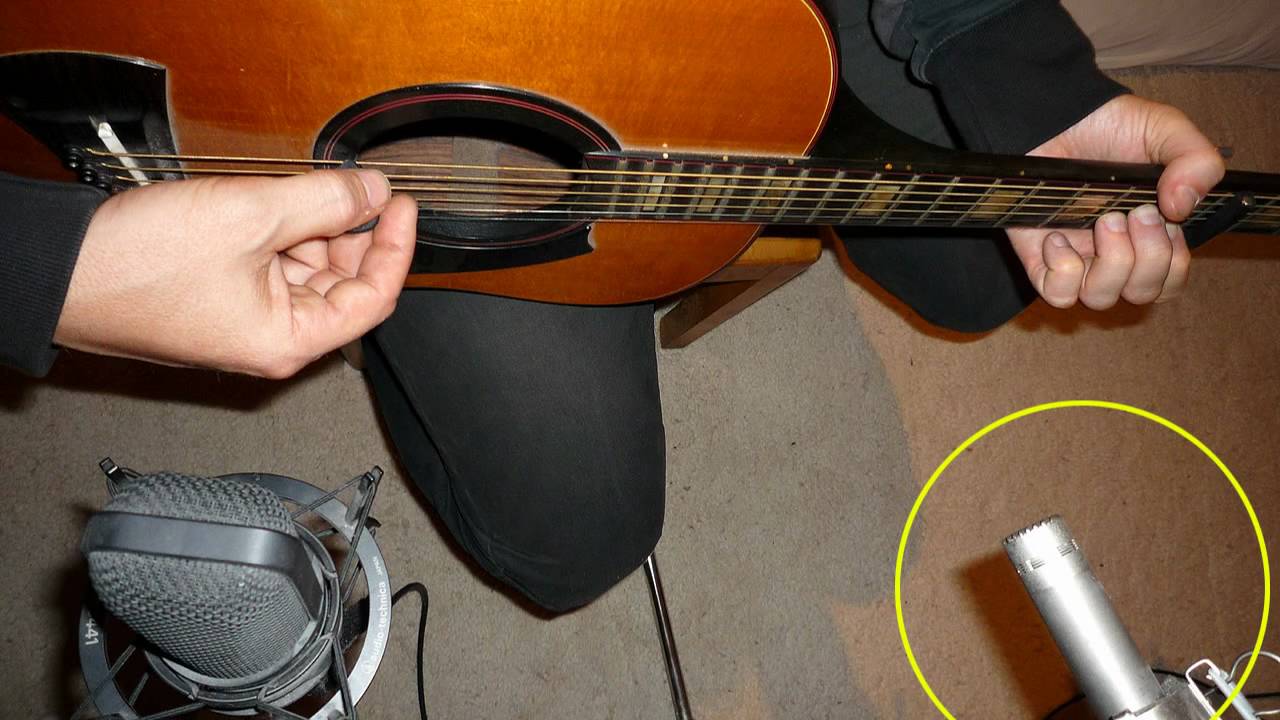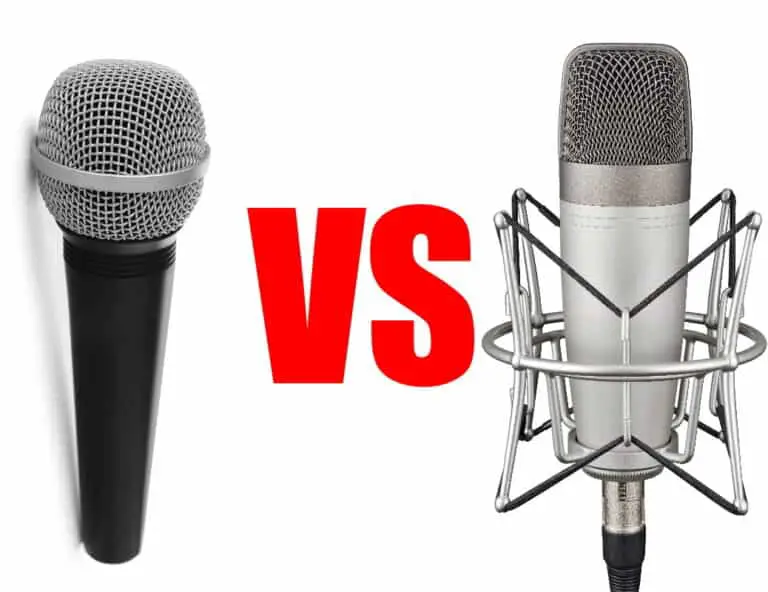Are you a musician recording acoustic guitar? Unsure on how to choose the best microphone for recording? This article will guide you through understanding condenser and dynamic microphones, their uses and importance, helping you make the perfect choice for your music.
Let’s discover the difference between condenser vs dynamic mics and make sure your recordings sound professional!
This guide aims to help you find the best microphone for recording acoustic guitar. Whether you’re looking for a condenser mic or dynamic, this article provides an in-depth look at different types of mics and their ideal applications.
By focusing on the main categories, we will explore features and discuss why certain mics are better suited for certain projects. The goal is to give you a comprehensive overview of what’s out there so that you can make an informed decision when it comes time to choose a microphone for your acoustic guitar recordings.
We will start off with a brief overview of the two main types of microphones – Condenser and Dynamic – before diving into more specific details about their individual components, characteristics, strengths and weaknesses. From there we’ll discuss specifics like patterns and polarities as well as some tips on use and placement.
Finally, we will provide several product recommendations for each category so that you can shop with confidence and pick the perfect mic for your setup!

Comparing Condenser and Dynamic Microphones for Recording Acoustic Guitar
When it comes to recording acoustic guitar, there are two main types of microphones to consider—condenser and dynamic. Let’s take a look at their differences so you can decide which one is right for your recording situation.
Condenser Microphones Condenser microphones are popular for recording acoustic guitar due to their ability to capture a wide range of frequencies from high treble tones down to low bass frequencies. This type of microphone requires an external power source, usually in the form of “phantom power” and has the capability of capturing transient detail very well.
Dynamic Microphones Dynamic microphones offer less sensitivity than condenser mics but offer the ability to handle high SPLs (sound pressure levels). This makes them great for loud sources such as live performances or instruments with high transients, like drums or amplified guitars. They don’t need an external power source, making them a great choice when portability is important. Dynamic microphones also tend to pick up less background noise than condenser mics due to their reduced sensitivity.
When it comes down to choosing between the two types of microphones for recording acoustic guitar, each one offers unique advantages and drawbacks that will depend on what type of sound you’re looking for and what instruments you’re using in the studio setting. Ultimately it will come down personal preference and which mic best complements your setup and production style.
Pros and cons of each type of microphone
As a musician, finding the right microphone to record acoustic guitar can be a daunting task. In order to make the best informed decision, it is important to understand the pros and cons of each type of microphone. Both condenser and dynamic microphones are suitable for recording acoustic guitar, however they excel in different areas so it’s important to decide which one will work best for your recording setup and musical genre.
Condenser microphones are generally preferred for capturing detailed sounds, including subtle nuances in sound. They have great frequency response and offer studio quality sound at closer distances. On the other hand, dynamic microphones have excellent transient response which makes them good at capturing percussion sounds as well as punchy electric guitars. These mics also offer decent gain before feedback when used in live shows.
The heat generated by a microphone while it is recording may also influence your choice – because of their larger diaphragms condenser microphones tend to run hot while dynamic mics are much cooler during use. When selecting a microphone for live performance or in an open environment like an amplifier, this could decide which way you go.
Additionally, dynamic mics generally have more rugged construction than condenser models and are less susceptible to shock damage or interference from vibrations or electronic equipment nearby – making them better suited for outdoor recordings or concerts where durability needs to be taken into account when selecting microphones. On the other hand if you’re looking for fine detail with clear and accurate reproduction from your acoustic guitar then using a condenser mic may be preferable regardless of where you’re recording or performing.
Considerations for choosing between condenser and dynamic microphones

Before deciding between condenser or dynamic microphones when looking for a microphone for recording acoustic guitars, there are several factors to consider. Microphone selection is an important factor of achieving the desired sound quality and it is best to experiment with a few different types before settling on the ideal microphone.
When recording on acoustic guitars, condenser microphones tend to be more sensitive and capture more of the nuances of the instrument’s sound. They are also better at picking up higher frequencies, making them a great choice for capturing full-frequency sounds. Condenser microphones come in a variety of sizes, shapes and polar patterns so it is important to try out different models before reaching a conclusion.
Dynamic microphones deliver a more direct sound with less subtlety than condensers, making them well suited to capturing rhythmic elements such as strumming and percussive accents in strummed pieces like rock or folk music. They are often slightly less sensitive than condensers which helps reduce background noise or unwanted vibration from other instruments. Dynamic microphones can come in both wired and wireless versions which allows for flexible placement around the instrumentalist during recordings or live performances.
Ultimately it depends on personal preference as well as specific genre requirements when choosing between either type of microphone for recording acoustic guitar work. Experimenting with both types will help determine which one works better in each individual situation and takes advantage of each type’s strengths.
Additional Factors to Consider When Choosing a Microphone for Recording Acoustic Guitar
Beyond the type of microphone and its frequency response, there are several other factors to consider when choosing the ideal mic for recording acoustic guitar. Here are a few of the most important ones:
Noise Level – A condenser microphone is inherently more sensitive than an dynamic mic; this means that is will pick up more subtle noises in your home studio setting, including computer fans and external noise bleed from other instruments or conversations. On the other hand, a dynamic mic may be better suited for use in a live setting since it can satisfy a broader range of sound sources without being overwhelmed by environmental noise.
Polar Pattern – The polar pattern of a microphone is a factor to consider when using it as an acoustic guitar mic because it controls directionality and pickup pattern. Generally speaking, an ultra-directional cardioid pattern will capture less ambient noise than an omnidirectional polar pattern. However, omnidirectional may be better for capturing room ambience which results in a fuller sound.
Phantom Power Needs – If you choose to go with one of the many popular condenser mics on the market today, or if your recording interface supports condenser mics, you will need phantom power to make them work properly. Generally this isn’t much of an issue since most audio interfaces come with built-in phantom power; but if you plan on taking your recording gear out of your home studio (i.e., doing field recordings), having access to individual batteries or portable phantom power units can be useful.
Polar patterns

When recording acoustic guitar, microphone polar patterns can be important decision-making factors. These patterns are responsible for how sound from a given source is picked up by the microphone, and their selection affects the overall result of a recording. When choosing a microphone for your acoustic guitar, understanding polar patterns and how they work in different situations is essential.
The two most common types of polar pattern for microphones are cardioid and omni. Cardioid microphones will pick up sound mainly from directly in front of them (known as its “front lobe”) with significantly less pickup of sound from behind or to the sides (known as its “back lobes”). Omni mics will essentially pick upe an equal amount of sound from all directions so it’s especially helpful when trying to capture sounds from multiple instruments that occupy similar frequency ranges.
In addition to these two basic types, there are also what are referred to as figure-eight mics which capture sounds on either side but not directly in front or back. While this can be useful for stereo recordings or certain kinds of experimentation, it should be avoided when recording acoustic guitar as it is not well suited for capturing the detailed nuances that make a great track.
When recording an acoustic guitar with one microphone, it is generally best practice to use a cardioid pattern in order to get a focused signal that minimizes distractions and other unwanted noise. If you use an omni pattern, you run the risk of picking up too many sounds in addition to your target signal which can create both mix issues and also just lessen overall clarity in the recorded instrumentation. The same goes when using multiple microphones – a mixture of cardioid patterns should be used unless you want a very wide open stereo field with reverberations included into the mix.
Frequency response
When considering which microphone to use for recording your acoustic guitar, frequency response is one of the most important things to take into account. Frequency response is the measure of how a microphone captures sound waves within a certain range of frequencies. There are two types of microphones with different frequency responses; condenser and dynamic microphones.
Condenser microphones have a wide frequency response which gives them the ability to capture both high and low frequencies and allows for greater versatility when recording acoustic guitars. This type of microphone typically has a more open sound compared to dynamic microphones which have more focused responses. Condenser mics are capable of capturing more subtle details like variations in pick attack and tone nuances, providing richer recordings overall.
Dynamic mics, on the other hand, have limited frequency response capabilities but can handle higher sound pressure levels than condensers due to their robust diaphragm construction. Dynamic mics are usually best suited for brighter sounding musical instruments like electric guitars whereas condensers are better at capturing the subtleties in the sound of acoustic guitars. However, both types can be used successfully when recording an acoustic guitar depending on what type of sound you’re trying achieve.
Sensitivity

A microphone’s sensitivity affects your recordings and the acoustic guitar you are recording. Microphones with higher sensitivity will pick up even the smallest details from the instrument being recorded and produce a larger output signal. This is often desirable for acoustic guitar, as it captures all the nuances and subtleties of each string’s vibration. On the other hand, microphones that are not sensitive enough may not provide enough signal to capture these details accurately. The differences between a condenser and dynamic microphone, in terms of sensitivity, can provide different sound textures to the recordings they make depending on what kind of response you need from the mic.
Condenser microphones are known for their high level of accuracy and detailed audio reproduction. These mics use an external power source like “phantom power” that increases their signal strength to offer improved results, especially when recording loud sources like electric guitars or drums. As such, they are often considered ideal choices for recording acoustic guitars due to their ability to pick up intricate sounds created by individual strings or notes played on them.
Dynamic microphones typically have lower sensitivity levels but provide some unique sonic characteristics that can enhance your recordings if used correctly. They are generally less susceptible to distortion and feedback even at high volume levels than condensers, making them suitable for capturing loud performances or live shows as well as quiet moments in songs where you want your acoustic guitars to be heard clearly without any additional noise coming in from other instruments in the mix down stage.
Noise level
One of the most important aspects to consider when selecting a microphone for recording acoustic guitar is the noise level that it produces. Most utilize either a condenser or dynamic microphone, both offering different amount of noise reduction.
Condenser microphones generally have higher sensitivity to sound and can pick up more details, but they also tend to be more sensitive to loud noises and have more self-noise. Dynamic microphones on the other hand produce less self-noise, allowing you to record quieter scenes without any additional noise. They also usually handle higher SPLs better than condensers, making them well suited for loud recordings like electric guitars or drums.
Noise levels are affected by many factors like the type of microphone being used, the preamplifier it is connected to and even the active components in your room like air conditioners or fans. To ensure that your recordings come out sounding as clean as possible it’s important to assess all these variables and make sure that you choose the best type of microphone for your specific recording needs.
Conclusion
In conclusion, when it comes to selecting a microphone for recording acoustic guitar, it is important to consider both Condenser and Dynamic microphones. Both types have their own advantages and disadvantages so it is important to make an informed decision based on your specific needs. Ultimately, the goal of any musician or engineer should be to get the best results possible when recording acoustic guitar.
In general, condenser microphones provide greater frequency response and higher sensitivity than dynamic microphones making them ideal for capturing a cleaner sound with greater detail. On the other hand, dynamic microphones are extremely rugged and typically require no phantom power or external preamps which makes them attractive options for use in live settings.
No matter which type of microphone you choose, make sure you take the time to experiment in order to find the right microphone for your setup. By doing so, you will be able to get the most out of your recordings and create music that will stand the test of time.
FAQs
What type of mic is best for recording acoustic guitar?
Condenser microphones are typically considered the best choice for recording acoustic guitar due to their sensitivity and ability to capture the nuances of the instrument’s sound.
What budget microphone to record acoustic guitar?
Some good budget microphones for recording acoustic guitar include the Audio-Technica AT2020, the Shure SM57, and the Rode NT1-A.
Which microphone to record guitar?
There are many great microphone options for recording acoustic guitar, but some popular choices include the Neumann KM 184, the AKG C414, and the Audio-Technica AT4053b.
What is the best recording setup for acoustic guitar?
The best recording setup for acoustic guitar can vary depending on the desired sound and the available equipment, but a common setup involves using a condenser microphone positioned near the guitar’s soundhole or fingerboard, along with additional microphones or pickup systems to capture the instrument’s resonance.
Do you need 2 mics to record acoustic guitar?
While it is not always necessary, using two microphones can allow for greater control over the recorded sound, as one microphone can be used to capture the guitar’s body resonance while the other focuses on the strings and fretboard.
Should I record acoustic guitar with condenser or dynamic mic?
Condenser microphones are typically preferred for recording acoustic guitar, as they are more sensitive and can capture a wider range of frequencies and dynamics than dynamic microphones.
Is condenser mic good for recording acoustic guitar?
Yes, condenser microphones are generally considered the best option for recording acoustic guitar due to their sensitivity and ability to capture the nuances of the instrument’s sound.
Is it better to mic an acoustic guitar?
Miking an acoustic guitar can allow for a more natural and authentic sound compared to using pickup systems or direct inputs, as the microphone can capture the guitar’s resonances and subtle nuances.
Is acoustic guitar good for recording?
Yes, acoustic guitars are commonly used in recording studios due to their versatility and ability to produce a wide range of tones and styles.
What mic do most musicians use?
The microphone choices of musicians can vary widely depending on personal preference and the specific recording needs, but some popular choices among professionals include the Neumann U87, Shure SM7B, and AKG C414.
See Also :
- Best kitchen sink strainer 2023
- Best 28 inch undermount kitchen sink 2023
- Best kitchen sink material 2023
- Best hair catcher for bathroom sink 2023
- Best granite kitchen sink 2023

